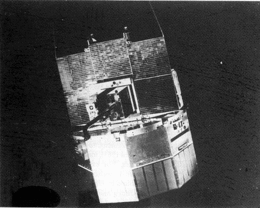 The OSO 7 satellite, like the other Orbiting Solar Observatory missions, was primarily a solar observatory designed to point a battery of UV and X-ray telescopes at the Sun from a stabilized "sail" pointing platform mounted on a rotating cylindrical "wheel". | |
| Operator | NASA |
|---|---|
| COSPAR ID | 1971-083A |
| SATCAT no. | 05491 |
| Mission duration | 3 years |
| Spacecraft properties | |
| Manufacturer | Ball Brothers Research Corporation (BBRC) |
| Launch mass | 635 kilograms (1,400 lb) |
| Start of mission | |
| Launch date | 29 September 1971, 09:50:00 UTC |
| Rocket | Delta-N |
| Launch site | Cape Kennedy LC-17A |
| End of mission | |
| Decay date | 9 July 1974 |
| Orbital parameters | |
| Reference system | Geocentric |
| Eccentricity | 0.018376 |
| Perigee altitude | 321.0 kilometers (199.5 mi) |
| Apogee altitude | 572.0 kilometers (355.4 mi) |
| Inclination | 33.10 degrees |
| Period | 93.20 minutes |
| Mean motion | 15.45 |
| Epoch | 29 September 1971, 05:50:00 UTC[1] |
OSO 7 or Orbiting Solar Observatory 7 (NSSDC ID: 1971-083A), before launch known as OSO H is the seventh in the series of American Orbiting Solar Observatory satellites launched by NASA between 1962 and 1975.[2] OSO 7 was launched from Cape Kennedy (now Cape Canaveral) on 29 September 1971 by a Delta N rocket into a 33.1° inclination, low-Earth (initially 321 by 572 km) orbit, and re-entered the Earth's atmosphere on 9 July 1974. It was built by the Ball Brothers Research Corporation (BBRC), now known as Ball Aerospace, in Boulder Colorado.
While the basic design of all the OSO satellites was similar, the OSO 7 was larger [total spacecraft mass was 635 kg (1397 lb)] than the OSO 1 through OSO 6, with a larger squared-off solar array in the non-rotating "Sail", and a deeper rotating section, the "Wheel".[3]
- ^ "NASA – NSSDCA – Spacecraft – Trajectory Details". nssdc.gsfc.nasa.gov. Retrieved 2 May 2018.
- ^ OSO 7 NASA HEASARC
- ^ OSO 7 in orbit A photograph of the OSO 7 taken before launch, on a black background as it might have appeared in space.